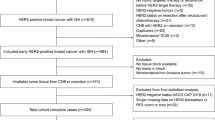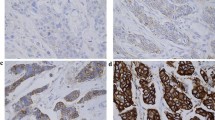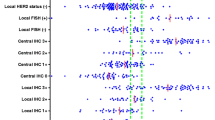Abstract
Human epidermal growth factor receptor 2 (HER2) testing is an essential part of pathological assessment in breast cancer patients, as HER2 provides not only prognostic but also predictive information on response to targeted therapy. So far, HER2 test accuracy of immunohistochemistry/in situ-hybridization techniques is still under debate, and more reliable and robust technologies are needed. To address this issue and to evaluate the predictive value of HER2 on chemotherapy, we investigated a cohort of 278 patients from the GeparTrio trial, a prospective neoadjuvant anthracycline/taxane-based multicenter study. In the GeparTrio trial, patients were not treated with any anti-HER2 therapy, as this was not standard therapy at this time. The HER2 status was analyzed by three different approaches: local and central evaluation using immunohistochemistry combined with in situ-hybridization as well as evaluation of HER2 mRNA expression using kinetic RT-PCR from formalin-fixed, paraffin-embedded (FFPE) tissue samples using a predefined cutoff. HER2 overexpression/amplification was observed in 37.3% (91/244) and 17.9% (41/229) of the informative samples in the local and central evaluations, respectively. Positive HER2 mRNA levels were found in 19.8% (55/278). We observed a highly significant correlation between central HER2 expression and HER2 status measured by kinetic RT-PCR (r = 0.856, P < 0.0001) and an overall agreement of 95.6% (κ statistic, 0.862, CI 0.77–0.94). Further, central HER2 as well as HER2 mRNA expression were predictors for a pathological complete response after neoadjuvant anthracycline/taxane-based primary chemotherapy in a univariate binary logistic regression analysis (OR 3.29, P = 0.002; OR 2.65, P = 0.004). The predictive value could be confirmed for the central HER2 status by multivariate analysis (OR 3.04, P = 0.027). The locally assessed HER2 status was not predictive of response to chemotherapy. Our results suggest that standardized methods are preferable for evaluation of HER2 status. The kinetic RT-PCR from FFPE tissue might be an additional approach for assessment of this important prognostic and predictive parameter but has to be confirmed by other studies.

Similar content being viewed by others
Abbreviations
- CI:
-
Confidence interval
- ER:
-
Estrogen receptor
- FISH:
-
Fluorescence in situ-hybridization
- FFPE:
-
Formalin-fixed, paraffin-embedded
- HER2:
-
Human epidermal growth factor receptor 2
- HR:
-
Hormone receptor
- NCT:
-
Neoadjuvant chemotherapy
- NX:
-
Vinorelbine, capecitabine
- pCR:
-
Pathological complete response
- OR:
-
Odds ratio
- PgR:
-
Progesterone receptor
- SISH:
-
Silver-enhanced in situ-hybridization
- TAC:
-
Docetaxel, doxorubicin, and cyclophosphamide
References
Yaziji H, Gown AM (2004) Accuracy and precision in her2/neu testing in breast cancer: are we there yet? Hum Pathol 35:143–146
Press MF, Slamon DJ, Flom KJ, Park J, Zhou JY, Bernstein L (2002) Evaluation of her-2/neu gene amplification and overexpression: comparison of frequently used assay methods in a molecularly characterized cohort of breast cancer specimens. J Clin Oncol 20:3095–3105
Lebeau A, Deimling D, Kaltz C, Sendelhofert A, Iff A, Luthardt B, Untch M, Lohrs U (2001) Her-2/neu analysis in archival tissue samples of human breast cancer: comparison of immunohistochemistry and fluorescence in situ hybridization. J Clin Oncol 19:354–363
Thomson TA, Hayes MM, Spinelli JJ, Hilland E, Sawrenko C, Phillips D, Dupuis B, Parker RL (2001) Her-2/neu in breast cancer: interobserver variability and performance of immunohistochemistry with 4 antibodies compared with fluorescent in situ hybridization. Mod Pathol 14:1079–1086
Gown AM (2008) Current issues in ER and HER2 testing by IHC in breast cancer. Mod Pathol 21(Suppl 2):8–15
Paik S, Kim C, Wolmark N (2008) Her2 status and benefit from adjuvant trastuzumab in breast cancer. N Engl J Med 358:1409–1411
Koutras AK, Kalogeras KT, Dimopoulos MA, Wirtz RM, Dafni U, Briasoulis E, Pectasides D, Gogas H, Christodoulou C, Aravantinos G, Zografos G, Timotheadou E, Papakostas P, Linardou H, Razis E, Economopoulos T, Kalofonos HP, Fountzilas G (2008) Evaluation of the prognostic and predictive value of her family mRNA expression in high-risk early breast cancer: a hellenic cooperative oncology group (HECOG) study. Br J Cancer 99:1775–1785
Bohmann K, Hennig G, Rogel U, Poremba C, Mueller BM, Fritz P, Stoerkel S, Schaefer KL (2009) RNA extraction from archival formalin-fixed paraffin-embedded tissue: a comparison of manual, semiautomated, and fully automated purification methods. Clin Chem 55:1719–1727
von Minckwitz G, Kummel S, Vogel P, Hanusch C, Eidtmann H, Hilfrich J, Gerber B, Huober J, Costa SD, Jackisch C, Loibl S, Mehta K, Kaufmann M (2008) Intensified neoadjuvant chemotherapy in early-responding breast cancer: phase III randomized GeparTrio study. J Natl Cancer Inst 100:552–562
von Minckwitz G, Kummel S, Vogel P, Hanusch C, Eidtmann H, Hilfrich J, Gerber B, Huober J, Costa SD, Jackisch C, Loibl S, Mehta K, Kaufmann M (2008) Neoadjuvant vinorelbine-capecitabine versus docetaxel-doxorubicin-cyclophosphamide in early nonresponsive breast cancer: phase III randomized GeparTrio trial. J Natl Cancer Inst 100:542–551
Huober J, von Minckwitz G, Denkert C, Tesch H, Weiss E, Zahm DM, Belau A, Khandan F, Hauschild M, Thomssen C, Hogel B, Darb-Esfahani S, Mehta K, Loibl S (2010) Effect of neoadjuvant anthracycline-taxane-based chemotherapy in different biological breast cancer phenotypes: overall results from the GeparTrio study. Breast Cancer Res Treat 124:133–140
Hayes DF, Ethier S, Lippman ME (2006) New guidelines for reporting of tumor marker studies in breast cancer research and treatment: remark. Breast Cancer Res Treat 100:237–238
McShane LM, Altman DG, Sauerbrei W, Taube SE, Gion M, Clark GM (2006) Reporting recommendations for tumor marker prognostic studies (remark). Breast Cancer Res Treat 100:229–235
Wolff AC, Hammond ME, Schwartz JN, Hagerty KL, Allred DC, Cote RJ, Dowsett M, Fitzgibbons PL, Hanna WM, Langer A, McShane LM, Paik S, Pegram MD, Perez EA, Press MF, Rhodes A, Sturgeon C, Taube SE, Tubbs R, Vance GH, van de Vijver M, Wheeler TM, Hayes DF (2007) American society of clinical oncology/college of american pathologists guideline recommendations for human epidermal growth factor receptor 2 testing in breast cancer. J Clin Oncol 25:118–145
Darb-Esfahani S, Loibl S, Muller BM, Roller M, Denkert C, Komor M, Schluns K, Blohmer JU, Budczies J, Gerber B, Noske A, du Bois A, Weichert W, Jackisch C, Dietel M, Richter K, Kaufmann M, von Minckwitz G (2009) Identification of biology-based breast cancer types with distinct predictive and prognostic features: role of steroid hormone and HER2 receptor expression in patients treated with neoadjuvant anthracycline/taxane-based chemotherapy. Breast Cancer Res 11:R69
Müller BM (2009) Quantitative determination of predictive cancer biomarkers in formalin-fixed, paraffin-embedded tissue using a new fully automated method for RNA isolation. J Clin Oncol 27 (suppl, abstr 11032)
Iverson AA, Gillett C, Cane P, Santini CD, Vess TM, Kam-Morgan L, Wang A, Eisenberg M, Rowland CM, Hessling JJ, Broder SE, Sninsky JJ, Tutt A, Anderson S, Chang SY (2009) A single-tube quantitative assay for mRNA levels of hormonal and growth factor receptors in breast cancer specimens. J Mol Diagn 11:117–130
Ginestier C, Charafe-Jauffret E, Penault-Llorca F, Geneix J, Adelaide J, Chaffanet M, Mozziconacci MJ, Hassoun J, Viens P, Birnbaum D, Jacquemier J (2004) Comparative multi-methodological measurement of ERBB2 status in breast cancer. J Pathol 202:286–298
Vinatzer U, Dampier B, Streubel B, Pacher M, Seewald MJ, Stratowa C, Kaserer K, Schreiber M (2005) Expression of HER2 and the coamplified genes GRB7 and MLN64 in human breast cancer: quantitative real-time reverse transcription-pcr as a diagnostic alternative to immunohistochemistry and fluorescence in situ hybridization. Clin Cancer Res 11:8348–8357
Kaufmann M, Hortobagyi GN, Goldhirsch A, Scholl S, Makris A, Valagussa P, Blohmer JU, Eiermann W, Jackesz R, Jonat W, Lebeau A, Loibl S, Miller W, Seeber S, Semiglazov V, Smith R, Souchon R, Stearns V, Untch M, von Minckwitz G (2006) Recommendations from an international expert panel on the use of neoadjuvant (primary) systemic treatment of operable breast cancer: an update. J Clin Oncol 24:1940–1949
Rastogi P, Anderson SJ, Bear HD, Geyer CE, Kahlenberg MS, Robidoux A, Margolese RG, Hoehn JL, Vogel VG, Dakhil SR, Tamkus D, King KM, Pajon ER, Wright MJ, Robert J, Paik S, Mamounas EP, Wolmark N (2008) Preoperative chemotherapy: updates of national surgical adjuvant breast and bowel project protocols b-18 and b-27. J Clin Oncol 26:778–785
Kaufmann M, von Minckwitz G, Bear HD, Buzdar A, McGale P, Bonnefoi H, Colleoni M, Denkert C, Eiermann W, Jackesz R, Makris A, Miller W, Pierga JY, Semiglazov V, Schneeweiss A, Souchon R, Stearns V, Untch M, Loibl S (2007) Recommendations from an international expert panel on the use of neoadjuvant (primary) systemic treatment of operable breast cancer: new perspectives 2006. Ann Oncol 18:1927–1934
Tan MC, Al Mushawah F, Gao F, Aft RL, Gillanders WE, Eberlein TJ, Margenthaler JA (2009) Predictors of complete pathological response after neoadjuvant systemic therapy for breast cancer. Am J Surg 198:520–525
Colleoni M, Viale G, Zahrieh D, Pruneri G, Gentilini O, Veronesi P, Gelber RD, Curigliano G, Torrisi R, Luini A, Intra M, Galimberti V, Renne G, Nole F, Peruzzotti G, Goldhirsch A (2004) Chemotherapy is more effective in patients with breast cancer not expressing steroid hormone receptors: a study of preoperative treatment. Clin Cancer Res 10:6622–6628
Liedtke C, Mazouni C, Hess KR, Andre F, Tordai A, Mejia JA, Symmans WF, Gonzalez-Angulo AM, Hennessy B, Green M, Cristofanilli M, Hortobagyi GN, Pusztai L (2008) Response to neoadjuvant therapy and long-term survival in patients with triple-negative breast cancer. J Clin Oncol 26:1275–1281
Huober J (2009) Neoadjuvant chemotherapy in operable breast cancer with docetaxel, doxorubicin, and cyclophosphamide (TAC) or TAC followed by vinorelbine and capecitabine (NX): final results and analysis of markers predicting response to treatment. J Clin Oncol 27 (suppl, abstr 524)
Rody A, Karn T, Solbach C, Gaetje R, Munnes M, Kissler S, Ruckhaberle E, Minckwitz GV, Loibl S, Holtrich U, Kaufmann M (2007) The ERBB2 + cluster of the intrinsic gene set predicts tumor response of breast cancer patients receiving neoadjuvant chemotherapy with docetaxel, doxorubicin and cyclophosphamide within the GeparTrio trial. Breast 16:235–240
Jones RL, Salter J, A’Hern R, Nerurkar A, Parton M, Reis-Filho JS, Smith IE, Dowsett M (2010) Relationship between oestrogen receptor status and proliferation in predicting response and long-term outcome to neoadjuvant chemotherapy for breast cancer. Breast Cancer Res Treat 119:315–323
Arriola E, Rodriguez-Pinilla SM, Lambros MB, Jones RL, James M, Savage K, Smith IE, Dowsett M, Reis-Filho JS (2007) Topoisomerase II alpha amplification may predict benefit from adjuvant anthracyclines in HER2 positive early breast cancer. Breast Cancer Res Treat 106:181–189
Rouzier R, Perou CM, Symmans WF, Ibrahim N, Cristofanilli M, Anderson K, Hess KR, Stec J, Ayers M, Wagner P, Morandi P, Fan C, Rabiul I, Ross JS, Hortobagyi GN, Pusztai L (2005) Breast cancer molecular subtypes respond differently to preoperative chemotherapy. Clin Cancer Res 11:5678–5685
Carey LA, Dees EC, Sawyer L, Gatti L, Moore DT, Collichio F, Ollila DW, Sartor CI, Graham ML, Perou CM (2007) The triple negative paradox: primary tumor chemosensitivity of breast cancer subtypes. Clin Cancer Res 13:2329–2334
Guarneri V, Broglio K, Kau SW, Cristofanilli M, Buzdar AU, Valero V, Buchholz T, Meric F, Middleton L, Hortobagyi GN, Gonzalez-Angulo AM (2006) Prognostic value of pathologic complete response after primary chemotherapy in relation to hormone receptor status and other factors. J Clin Oncol 24:1037–1044
Andre F, Mazouni C, Liedtke C, Kau SW, Frye D, Green M, Gonzalez-Angulo AM, Symmans WF, Hortobagyi GN, Pusztai L (2008) HER2 expression and efficacy of preoperative paclitaxel/FAC chemotherapy in breast cancer. Breast Cancer Res Treat 108:183–190
Lebeau A, Turzynski A, Braun S, Behrhof W, Fleige B, Schmitt WD, Grob TJ, Burkhardt L, Holzel D, Jackisch C, Thomssen C, Muller V, Untch M (2010) Reliability of human epidermal growth factor receptor 2 immunohistochemistry in breast core needle biopsies. J Clin Oncol 28:3264–3270
Acknowledgments
We would like to thank Mrs. Petra Wachs, Mrs. Gabriela Altmann, and Mrs. Claudia Roth for her excellent technical assistance.
Conflict of interest
The authors declare that they have no competing interests. Ralf Kronenwett, Christian von Törne, and Ralph Wirtz are employees of Siemens Healthcare Diagnostics, Cologne, Germany.
Author information
Authors and Affiliations
Corresponding author
Rights and permissions
About this article
Cite this article
Noske, A., Loibl, S., Darb-Esfahani, S. et al. Comparison of different approaches for assessment of HER2 expression on protein and mRNA level: prediction of chemotherapy response in the neoadjuvant GeparTrio trial (NCT00544765). Breast Cancer Res Treat 126, 109–117 (2011). https://doi.org/10.1007/s10549-010-1316-y
Received:
Accepted:
Published:
Issue Date:
DOI: https://doi.org/10.1007/s10549-010-1316-y




